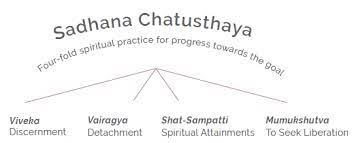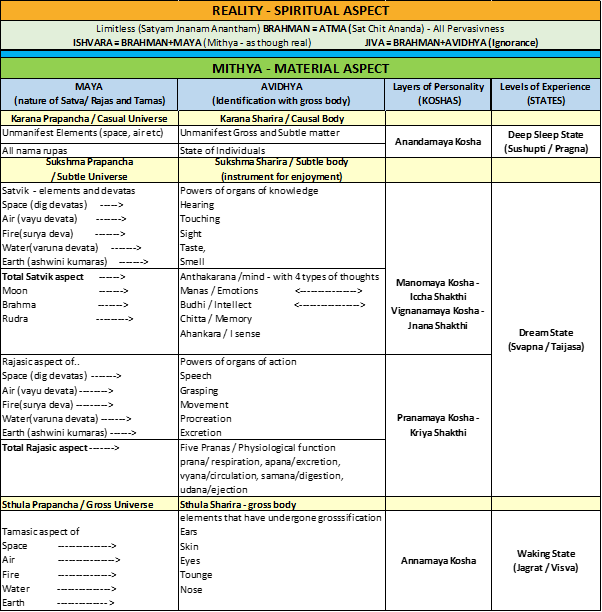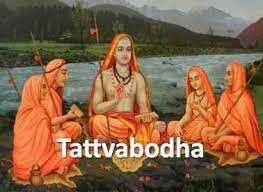Tattva Bodha is a concise guide that explains the important ideas of Advaita Vedanta in a clear and organized way. It was written by the respected sage Shri Adi Shankaracharya and opens the door to a world where reality and wisdom come together in a special way. It encourages us to think deeply about the true nature of reality (Brahman), our own selves (Atman), the idea of illusion (Maya), the connection between Brahman and Atman, and how to achieve liberation (moksha).
The phrase “Tattva Bodha” means knowledge of the truth. But what truth does it refer to? It refers to the truth about ourselves, the world, and God. We study Tattva Bodha as a preparation before diving into other scriptural texts like the Bhagavad Gita, Uddhava Gita, or the Upanishads. It lays the foundation for a deeper understanding of these texts and helps us gain insight into the fundamental truths of life.
This Tattva Bodha text can be divided into five topics.
- Qualifications (eligibility) required for Vedantic study.
- Analysis of the individual, Vyashtihi – Microcosm.
- Analysis of the Samashtihi, the total – Macrocosm.
- Vyashtihi Samashtihi Svarupa Aikyam – essential oneness of the individual and total
- Aikya Jnana Phalam – Benefit of Tattva Bodha Knowledge
Sadhana Chatushtaya – Eligibility for Vedantic Study
What is Sadhana Chatushtaya in Vedanta? Sadhana Chatushtaya Sampatti is a term used in Vedantic study to refer to the fourfold qualifications or prerequisites for spiritual practice. They prepare the aspirant for the study and understanding of Vedanta, and they create the necessary inner conditions for self-inquiry, contemplation, and realization of the ultimate truth. The four components of Sadhana Chatushtaya are- Viveka, Vairagya, Shamaadhi Shatka Sampatih (Shat Sampatti) and Mumukshuthvam

Sadhana Chatushtaya – Viveka
Viveka means discrimination or discernment. It refers to the ability to distinguish between the eternal and the temporary, the real and the unreal, the Self (Atman) and the non-Self (Anatman). Viveka enables individuals to recognize the impermanence and limitations of the world and to discern the unchanging and eternal nature of the Self.
Sadhana Chatushtaya – Vairagya
What is Vairagya? Vairagya denotes dispassion or detachment. It involves cultivating a state of mind where one develops a non-attachment toward worldly objects, experiences, and desires. Vairagya does not imply renouncing or giving up worldly responsibilities, but rather developing an inner detachment and reducing one’s dependence on external sources of happiness.
Shamaadhi Shatka Sampatih – Shat Sampatti
Shat Sampatti refers to a set of six qualities that contribute to mental discipline and inner stability. These qualities include
1) Shama – control of the mind
2) Dama – control of the senses
3) Uparati – withdrawal from worldly pursuits
4) Titiksha – endurance of challenges and difficulties),
5) Shraddha (faith and trust in the teachings), and
6) Samadhana (one-pointedness and focus of the mind).
Cultivating these qualities helps in developing a calm and focused mind, essential for self-inquiry and spiritual growth.
Sadhana Chatushtaya – Mumukshuthvam
Mumukshuthvam means the intense desire for liberation or freedom. It is the yearning to break free from the cycle of birth and death and to realize one’s true nature as the Self. Mumukshuthvam is characterized by strong motivation and single-minded pursuit of self-realization. It fuels the determination and perseverance required to overcome obstacles and continue on the spiritual path.
Analysis of the Individual, Vyashtihi – Microcosm
Each person is generally divided into two categories: the Material aspect and the Spiritual aspect.

Material Aspect
Material body part is divided into 11 portions – 3 types of bodies, 5 Koshas (sheaths) of the body, and 3 States of experience. Advaita Vedanta, through Tattva Bodha teaches that the true Self or Atman is distinct from these 3 bodies, 5 Koshas, and the 3 states of experiences. It is the eternal, unchanging reality that transcends all the limitations of body, mind, and intellect.
Sthula Sukshma Karana Sharira – Three Types of Bodies
These three bodies, Stula, Sukshma, and Karana, are interrelated and provide different layers of manifestation and experience for the individual.
Gross Body (Sthula Sharira): refers to the visible physical body, formed from gross five elements: earth, water, fire, air, and space after the Panchikaranam process. It is subject to birth, growth, decay, and death, and associated with Annamyaya Kosha
Subtle Body (Sukshma Sharira): It consists of the invisible mind (Manas), intellect (Buddhi), and ego (Ahamkara). Formed from the subtle five elements before the process of Panchikaranam. Is responsible for our thoughts, emotions, desires, and the processing of sensory information. The Subtle Body is associated with the Pranamaya Kosha, Manomaya Kosha, and Vijnanamaya Kosha.
Causal Body (Karana Sharira): Here the physical and subtle body exists in seed form, the deepest and subtlest aspect of our existence. It is the root cause of our individuality and the source of our desires and tendencies. The Causal Body is associated with the deep sleep state and is responsible for the creation of future births and experiences. The Causal Body is also linked to the Anandamaya Kosha, which represents the bliss sheath or the aspect of supreme joy.
Five Koshas (Sheaths) of the Body
The Pancha Koshas serve as a framework to understand the layers of human existence, from the physical to the spiritual. Tattva Bodha teaches that the true Self or Atman is distinct from these koshas and is the eternal.
Annamaya Kosha: This is the physical sheath made up of food (anna). The Annamaya Kosha is composed of the five elements—earth, water, fire, air, and space—and encompasses the physical organs and systems representing the gross body.
Pranamaya Kosha: This is the vital sheath or the life force sheath. It represents the energy or prana that sustains and enlivens the physical body. The Pranamaya Kosha includes the various physiological functions, breath, and subtle energy channels (nadis) through which prana flows.
Manomaya Kosha: This is the mental sheath. It represents the mind (manas) and encompasses thoughts, emotions, desires, memories, and imagination. It is responsible for the processing of sensory information.
Vijnanamaya Kosha: This is the sheath of intellect. It represents higher intellectual faculties such as reasoning, discrimination, judgment, and decision-making. The Vijnanamaya Kosha is associated with the aspect of knowledge and wisdom.
Anandamaya Kosha: This is the bliss sheath or the sheath of supreme joy. It represents the deepest level of happiness and fulfillment that can be experienced. The Anandamaya Kosha is associated with the state of profound bliss that arises from spiritual practices and realization.
Three States of Experiences
The three states of consciousness are – Jagrat (waking), Swapna (dream), and Sushupti (deep sleep). The three states of consciousness are impermanent and susceptible to changes. Tattva Bodha teaching involves recognizing one’s essential nature as the eternal and non-dual reality, beyond the limitations imposed by the waking, dream, and deep sleep states.
Jagrat (Waking State): Jagrat refers to the state of wakefulness, where we experience the world through our senses and interact with the external environment. In this state, our body, mind, and senses are active, and we engage in various activities, such as perceiving, thinking, speaking, and acting.
Swapna (Dream State): Swapna refers to the dream state that occurs during sleep. In this state, the mind creates a subjective reality that is separate from the external world.
Sushupti (Deep Sleep State): Sushupti refers to the state of deep sleep where there is an absence of dreams and conscious awareness of the external world. It is a state of profound rest where the mind and senses are temporarily suspended. In this state, the person is liberated from the dualities and constraints encountered in the waking and dream states.
The Spiritual Aspect
The Spiritual aspect – Atma Amshaha – is a non-material element that bestows consciousness upon the body. The individual’s physical part cannot possess consciousness independently. Why? Because it is comprised of matter, which we know to be inherently inert. The material part of the individual relies on borrowing consciousness from Atma. Only Atma imparts consciousness to the body, rendering it alive and sentient.
SAT-CHIT-ANANDA ATMA
This Atma is defined as SAT-CHIT-ANANDA Atma
SAT – refers to “existence” or “beingness.” It signifies the eternal, unchanging, and absolute reality that underlies all existence. Sat represents the timeless and unbounded aspect of reality, beyond the limitations of time, space, and causation. It serves as a substratum for all living and non-living beings that exists in existence.
CHIT – means “consciousness” or “awareness, It is the essential nature of all beings. Chit represents the aspect of reality that illuminates and gives rise to all experiences and perceptions. It is the knowing or witnessing aspect of consciousness that transcends individual minds and exists as the universal consciousness.
ANANDA – signifies “bliss” or “joy.” It represents the supreme happiness and fulfilment that arises from the realization of one’s true nature and the union with the divine. Ananda is not merely happiness derived from external circumstances but a deep and abiding state of inner bliss that transcends the fluctuations of worldly experiences.
Analysis of the Total, Samashti – Macrocosm
This topic involves the analysis of the entirety, known as Samashti. Here, it is asserted that the universe is never created, which is a crucial concept to understand and absorb. This is based on the fundamental law that matter can neither be created nor destroyed. If the universe were to come into existence at a specific time, it must have existed in a dormant, seed-like form. This dormant state is referred to as Karana Prapanca, the causal universe, similar to the causal body
Prior to the emergence of the universe, there existed another eternal principle known as consciousness, which must have predated its arrival. This eternal consciousness is called Brahman. In the context of the individual, this same consciousness is referred to as Atma. However, when discussing the entirety, it is called Brahman.
Therefore, before the universe originated, two things were present: Karana Prapanca, the material principle, and Brahman, the spiritual principle. Karana Prapanca is also known as Maya and possesses three qualities or Gunas called Satva, Rajas, and Tamas.
The Satvic aspect of subtle elements evolved into the subtle universe, Sukshma Prapanca, which comprises all subtle bodies, including the organs of perception, the mind, and all knowledge in the universe.
The Rajasic aspect of subtle elements evolved into the organs of action such as speech, hands, legs, genitals, and anus.
Finally, the Tamasic aspect of subtle elements gave rise to the gross body through the process of Pancheekaranam, resulting in the visible universe, Stula Prapanca.
Consequently, in parallel with the three bodies (Shariram), we discuss three realms (Prapanchas). These three bodies are permeated and blessed by the principle of consciousness known as ATMA. And the three Prapanchas as well are blessed by the same consciousness and it is referred to as BRAHMAN.
Jivatma represents the manifestation of Atma in the individual, while the same Atma or Brahman blesses the macro universe by harmonizing it and upholding the cosmic physical and moral laws, including the law of Karma
The harmonizing intelligence behind it is known as Ishvara. Jiva represents the consciousness manifested in the three bodies, while Ishvara represents the consciousness manifested in the form of rhythm, harmony, and more. Both Jiva and Ishvara are names for that consciousness, referred to as Chaitanyam
Essential Oneness of the Individual and Total – Vyashtihi Samashtihi Svarupa Aikyam
When consciousness manifests within an individual, its characteristics differ due to the limitations of the individual. We possess limited knowledge, limited power, and so on, all because of the constraints imposed by our physical body, mind, and intellect.
In comparison, the very same consciousness manifesting in its entirety as Ishvara Chaitanya possesses omniscience, omnipotence, and other qualities, as the macro level encompasses complete knowledge and power.
According to Tattva Bodha, these differences in the manifested consciousness are solely due to the medium through which it expresses. The medium alone distorts consciousness.
Jivatma, the consciousness within the individual, and Paramatma, the consciousness within the entirety, are one and the same. However, within the medium of matter, they appear to be different
Hence, consciousness is inherently one, undivided, and uniform. Yet, when expressing through the medium of our body, mind, and sense organs, it seems to be diverse and manifold. Therefore, we dismiss this plurality at the level of Atma and understand the unity of Jivatma and Paramatma, claiming that I am that eternal Atma.
The body and mind are temporary mediums used for transactions, and when these mediums are unavailable, I do not engage in transactions, but I continue to exist. Therefore, the separation must be done in terms of understanding or wisdom.
Thus separating the micro and macro mediums by overlooking the distortions as incidental and embracing the distortion-free Original Consciousness is known as Vyashti Samashti Svarupa Aikyam, the unity of the individual and the entirety. This portion is referred to as the Mahā Vākyam portion of Tattva Bodha.
“I am the eternal and all-pervading consciousness principle”. This discovery helps me claim my immortality and helps me accept my body’s mortality and the mortality of the dear and near ones associated with name fame possession position relationship. The more I am aware of this fact the more I can confront life. Therefore this ATMA Jnana explained in TATTVA BODHA gives freedom.
Aikya Jnanam and Aikya Jnana Phalam – Benefits
Once I receive the wisdom that the essential nature is only one, the original Consciousness, and that’s my original nature, it should become my wisdom and a fact for me. This is achieved through Jnana Yoga pursuit consisting of threefold exercises called Sharavanam, Mananam and Nididyasanam.
Shravana refers to the act of hearing or listening to the teachings of the scriptures and the words of a qualified spiritual Guru involving consistent and systematic study. Through attentive listening and study, one gains clarity about the concepts, principles, and practices that lead to self-realization.
Manana helps to resolve any intellectual doubts or inconsistencies and strengthens one’s understanding of the teachings. Through this process of contemplation, the individual develops a clear and coherent intellectual grasp of the concepts of Advaita.
Nididhyasanam is the practice of sustained meditation and contemplation on the truth that has been intellectually understood. It is the process of internalizing and assimilating the knowledge gained through Shravana and Manana.
The benefits of this wisdom, the Jnana Phalam is twofold –
1) JivanMukti and 2) VidehaMukti
JeevanMukti is the total transformation. This refers to liberation while living. Here the individuals are free from the identification with the body, mind, and ego, and no longer experience the suffering and bondage associated with ignorance. In JivanMukti, one continues to live and engage in worldly activities but is untouched by the limitations and disturbances of the external world. They abide in a state of inner peace, joy, and unconditional love. JivanMukti is seen as the highest realization attainable in this lifetime.
VidehaMukti refers to liberation after death. It is the state of liberation attained upon the death of the physical body. In this state, the individual, having realized their true nature as the eternal self (Atman), is freed from the cycle of birth and death (samsara). They merge with the ultimate reality (Brahman) and transcend all individual limitations.
Tattva Bodha Conclusion
Liberation through Knowledge: Tattva Bodha emphasizes that liberation (Moksha) is attained through the knowledge of this essential oneness. By realizing one’s true nature as the infinite consciousness (Atman/Brahman) and understanding the illusory nature of individuality and separation, one can transcend the limitations of the ego and experience unity with the macrocosm.
The text encourages spiritual practices such as the study of scriptures (Shravana), self-inquiry (Manana), and meditation (Nididhyasana), to gain the knowledge that leads to liberation.
To conclude, Tattva Bodha provides a comprehensive overview of Advaita Vedanta, presenting the fundamental principles of the philosophy and guiding seekers towards the direct experience of their true nature as limitless consciousness or Brahman. It continues to be widely studied and commented upon by scholars, spiritual aspirants, and Vedanta teachers to this day.
Source- Introduction to Vedānta (Tattvabodha) Talks by – Swami Paramarthananda
- The Namagiri Thayar Mantra – For Wisdom, Creativity & Prosperity - April 29, 2024
- Krishnashtakam – “Krishnam Vande Jagadgurum” – Lyrics & Meaning - April 4, 2024
- Karadarshanam – “Karagre Vasate Lakshmi” – Meaning & Benefits - March 26, 2024


0 Comments